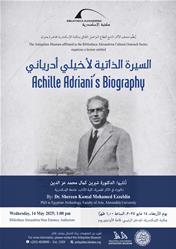Achille Adriani’s Biography at the Bibliotheca Alexandrina
Posted on

The BA Antiquities Museum organizes a lecture entitled “Achille Adriani’s Biography”, on Wednesday, 14 May 2025, at 1:00 pm, in the Auditorium Hall, BA Main Entrance. The lecture will be delivered by Dr. Shereen Kamal Mohamed Ezzeldin, PhD in Egyptian Archaeology, Faculty of Arts, Alexandria University.
Achille Adriani was an Italian archaeologist and one of the pioneers interested in Alexandrian art. He was born in Naples in 1905 and graduated from the Faculty of Letters, University of Rome, in 1927. He was then assigned to work on archaeological excavations at the necropolis of Veii in the Lazio region of Italy, where he was tasked with writing excavation reports. After graduation, he studied at the Italian School of Archaeology in Athens during the years 1928 and 1930 and participated in excavations on the island of Lemnos in Greece. Adriani was appointed Director of the Graeco-Roman Museum in Alexandria following the former director, Evaristo Breccia, serving two terms: from 1932 to 1940, and from 1948 to 1952. His directorship coincided with the outbreak of World War II, which led to the closure of the museum. Adriani oversaw building restoration works, modernized the museum displays, and reopened it to the public in 1949.
His study of Alexandria’s topography remains a cornerstone for those interested in the city's archaeological history. Among his major contributions were the discovery of the Mustafa Kamel archaeological site, the Ras Soda Temple, and the Alabaster Tomb. He also led numerous archaeological missions in Anfushi, Hadra, Chatby, Cleopatra, Abu Qir, Max, Mina El-Basal, Wardian, and Ras El-Tin. Regarding his academic publications, he issued the Annals of the Graeco-Roman Museum in four volumes, written in Italian and French, encompassing all his archaeological discoveries from 1932 to 1950.
Adriani permanently left Egypt in January 1953. He became a Professor of Classical Archaeology and Director of the Institute of Archaeology and History of Greek and Roman Art at the University of Palermo (1950–1966), before moving on to become Chair of Archaeology and History of Greek and Roman Art at the University of Naples (1966–1970). Finally, he assumed the same Chair at the University of Rome (1970–1975), where he remained until his death in 1982.